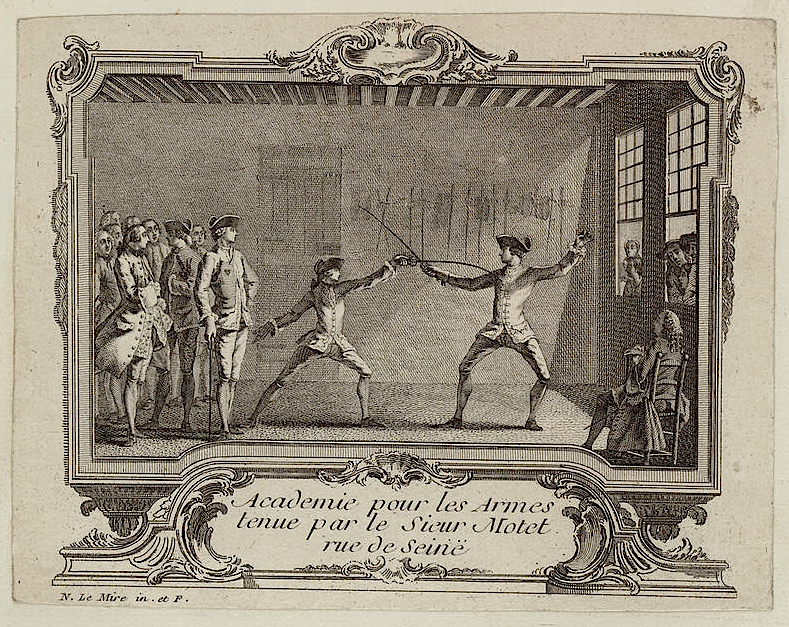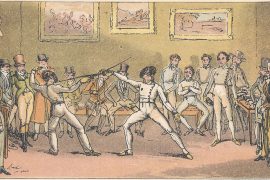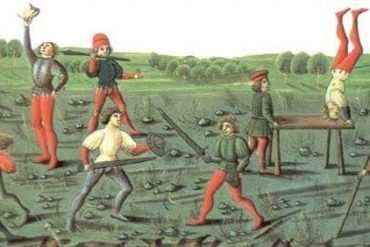Albrecht Dürer’s Οπλοδιδασκαλια sive Armorvm Tractandorvm Meditatio Alberti Dvreri (“Weapon Training, or Albrecht Dürer’s Meditation on the Handling of Weapons”, MS 26-232) is best known for its master-quality illustrations of longsword, messer, and dagger fencing. Most of this beautiful manuscript recreates the clumsier illustrations from works such as Codex Wallerstein or the Glasgow Manuscript, with a definite slant towards the “Nuremberg Tradition.”

Less-known are a handful of text-only sections, also most likely copies from other works. What follows is a translation of folio 101r, an anonymous work on the long sword sandwiched between copies of Ott Jud’s wrestling and Andre Liegnitzer’s fencing with the shortened sword. I completed this as a project for Daniel Jaquet’s Conference on Common Fencing, held in January 2017 in western Switzerland. I am particularly indebted to Dieter Bachman for invaluable insights, suggestions, corrections, and improvements to my translation. Keith Farrell worked through the physical interpretation with me (which also colored my translation) and Daniel Jaquet (who is publishing a facsimile and partial translation/transcription under the title The Albrecht Dürer Fight Book in September 2019) drew my attention to the source and introduced me to Dierk Hagedorn’s transcription. I owe this work to the four of these men.
A Few Notes on the Source and My Translation
The Anonymous Unicum contain six solo plays, presumably with the longsword without armor. While almost every play ends with some variation on “Thereafter you may do what you will,” each one appears to flow naturally out of the last, so that your final position at the end of the first “going” (German: Gang) is the starting position for the second, and your final position for the second becomes your opening position for the third, and so on. The entire sequence can be performed in a single, long parat (like Japanese kata).
The Unicum routinely abbreviates right and left side, rendered here as “r.s.”/“l.s.” or “r. side”/“l. side”). This is also done with the right arm, right hand, and left foot.
Several technical terms appear throughout the source, many of which are familiar to students of other Germanic longsword sources and appear to have the same or similar meanings: out-goings (Aus gen), wing (Flugel), plunge (Storz), shield (Schilt), and free-hew (Frei Hew). Some observations and assumptions about these and other terms:
- The meaning of “Free Hew” is still quite open to debate, but here is (perhaps arbitrarily) taken to mean a cut made without stepping or without chaining the legs to the cut.
- The plunge here is understood to be a cut from above into an upper hanging on the right (crossed-arms) side, perhaps not dissimilar to some interpretations of Liechtenauer’s Krump to the hands against Ochs; the shield here is understood to be a similar movement on the left (uncrossed-arms) side, not dissimilar to many interpretations of Liechtenauer’s Schielhau.
- The wing appears to be a long-edge unterhau with crossed arms (left side) thrown from a high/upright position, above the attacker’s belt, and aimed at the opponent’s elbows (c.f. Illustrations for Wallerstien’s Elbogen Hau, which is probably the same technique).
- Multiple terms are used to convey the idea of inversion or flipping the sword over, including inverted and overthrown.
- Rising cuts, unless otherwise specified, are assumed to be with the short edge (c.f. Ringeck’s Streychen); a survey of contemporary Germanic longsword sources suggests that this was the most common form of unterhau and appears to be almost ubiquitous in sources that include fencing from lower guards.
- One term—the Bridge (bruck)—is unclear, though in the absence of a better option I have interpreted it to be a transition over the head as part of a 180-degree change in facing, arcing the sword in a shield or plunge-like movement to bring the point to bear in the new direction.
- A “going” or a “go” (gang) is used in the way that other sources might use stück, play, or technique. I’ve kept the more literal translation due to the possible connection to schulfechten and competitive play, which often consisted of a series of rounds called “goes” (gänge), each limited to a set number of strikes (e.g. 4 or 6).
As a final note, those familiar with my work on Gemeines Fechten (Germanic common fencing) will find that the techniques and movement patterns in these plays are consistent with the themes drawn from contemporary non-Liechenaurian sources such as Paurñfeindt, Egenolph, Kölner, Wittenwiler, Hanko Döbringer and the “other masters” of 3227A, and so on. While the Unicum is no where near being a “complete system,” I do believe it’s representative of the sort of fencing practice commonly used in the German-speaking world of the late 15th/early 16th centuries. Also, while I was a trained linguist long ago, those days are quite past; any roughness or errors in translation are mine alone.
The Translation
Anonymous Unicum, Wien, Albertina 26-232 fol 101r
Here mark these are the out-goings from both sides
Item: from your right side, so swing your sword from both sides and let the sword fall behind your back. In this so grip at the pommel with your left hand and hit the flugel (wing) from the from the [sic] r.s. that your sword comes into the shield. Hit the overthrown (inverted) strike backwards and turn yourself around so you come again in the shield or after you may make a bridge inverted over the head. Thereafter you may do what you will.
The second going
Item: the second. When you have swung out (upwards) as before, so hit a free under-hew and invert the sword and step with the left foot backwards, so your sword comes to you on your left shoulder. In this strike from below upwards and invert and turn yourself boldly around so your sword sets itself behind (your) back outwardly against the man (opponent). Thereafter do what you will.
The third
When you have swung as before, so make a counter before you and step with the right foot to the left and hew the flugel (wing) over your r. arm and step with the l. foot backwards against the man (opponent) and turn your sword behind (your) back here out that your point stands against the man in the stortz (plunge). Thereafter do what you will, or fall there out in the under-plunge to your r. side.
Another
When you have hewed in the middle-hew to your l. s. that your sword here comes around with a stab on your r. arm against the man, thereafter strike against your r. s. and spring and invert in the height that your sword goes close to your l. foot above. Thereafter do the leap before the man or what you will.
Another going
Item: from your r. s. reverse your r. hand by the cross and your left by the pommel and leap on your r. s. in the shield there over a free leap as you will.
Item: know that the three counters are one. Take in the wide before you, the second under the right leg, the third in the center, and is after all one kind. Item: when you have swung on (upwards), so make a long counter in before you and turn the sword to the back, so strike up from the r. s. and invert in the height so your sword comes behind (your) back outward. Do thereafter what you will.





1 Comment